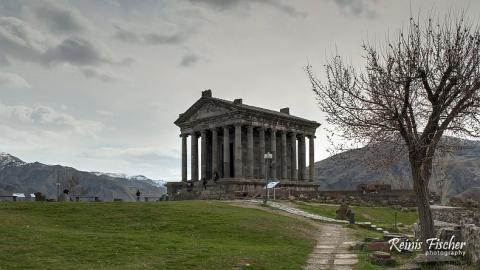The Temple of Garni is a classical Hellenistic temple in Garni, Armenia. It is perhaps the best-known structure and symbol of pre-Christian Armenia. It was probably built by king Tiridates I in the first century AD as a temple to the sun god Mihr.
We visited the Temple of Garni the next morning after our beautiful visit to Khor Virap monastery complex near border of Turkey. I called to my good old friend Tom (a taxi driver) and he picked us at our Park Hotel Yerevan, and off we were for the Temple of Garni and the nearby medieval monastery of Geghard. It was just later I learnt that both the Temple of Garni and monastery of Geghard are one of the main tourism objects in Armenia. Amazing. If I had a chance to add a must have attractions while in Armenia, I would suggest to visit Khor Virap monastery also.

The Temple of Garni
I was equipped with a tripod and some lens, no surprise I made a panoramic photography here.
After Armenia's conversion to Christianity in the early fourth century, it was converted into a royal summer house of Khosrovidukht, the sister of Tiridates III. According to some scholars it was not a temple but a tomb and thus survived the universal destruction of pagan structures. It collapsed in a 1679 earthquake. Renewed interest in the 19th century led to excavations at the site in mid-20th century and its eventual reconstruction between 1969 and 1975. It is the only known Greco-Roman colonnaded building in Armenia and the only standing such building in the former Soviet Union. It is one of the main tourist attractions in Armenia and the central shrine of Armenian neopaganism.

The Temple of Garni in HDR
Yes, HDR photography as well
The temple is at the edge of a triangular cliff and is part of the fortress of Garni . One of the oldest fortresses in Armenia, it is mentioned as Gorneas in the first-century Annals of Tacitus. The site is near the village of Garni, in Armenia's Kotayk Province and is officially known as the Garni Historical and Cultural Museum Reserve, which includes the temple, a bath complex, a royal summer palace, the seventh century church of St. Sion and other minor items (e.g., medieval khachkars). In total, the list of intangible historical and cultural monuments approved by the government of Armenia includes 11 items. It occupies 3.5 hectares (8.6 acres) and is supervised by the Service for the Protection of Historical Environment and Cultural Museum Reservations, an agency attached to the Ministry of Culture of the Republic of Armenia.

The temple of Garni
The precise construction date of the temple is unknown and is subject to debate. The dominant view is that it was built in 77 AD, during the eleventh year of the reign of king Tiridates I. In 1945 the painter Martiros Saryan discovered a Greek inscription, which named Tiridates the Sun (Helios) as the founder of the temple. The inscription, which probably came from the fortress wall of Garni and not the actual temple, is damaged and various readings are possible. One reading and translation is:
The Sun God Tiridates, uncontested king of Great Armenia built the temple and the impregnable fortress in the eleventh year of his reign when Mennieay was hazarapet [thousander, chiliarch] and Amateay was sparapet [general, commander].
The temple follows the style of classical Ancient Greek architecture which began developing in the seventh century BC. Scholars have variously described the structure as Greek, Roman or Greco-Roman and have usually linked it to Hellenistic art, often pointing out its distinct features and local Armenian influence. Some scholars have emphasized the Armenian influence on its architecture, calling it "Armenian-Hellenic" (Sahinian), while others have completely dismissed this view, calling it a "foreign structure on Armenian soil". Toros Toramanian, for instance, stressed the singularity of the temple as a Roman-style building on the Armenian Highlands and "remarked that the Garni construction essentially had no influence on contemporary or subsequent Armenian architecture." Sahinian, on the other hand, called it a "product of the architectural-constructional art of the Hellenistic period" that entirely resembles the 9th century BC Urartian Musasir temple.
